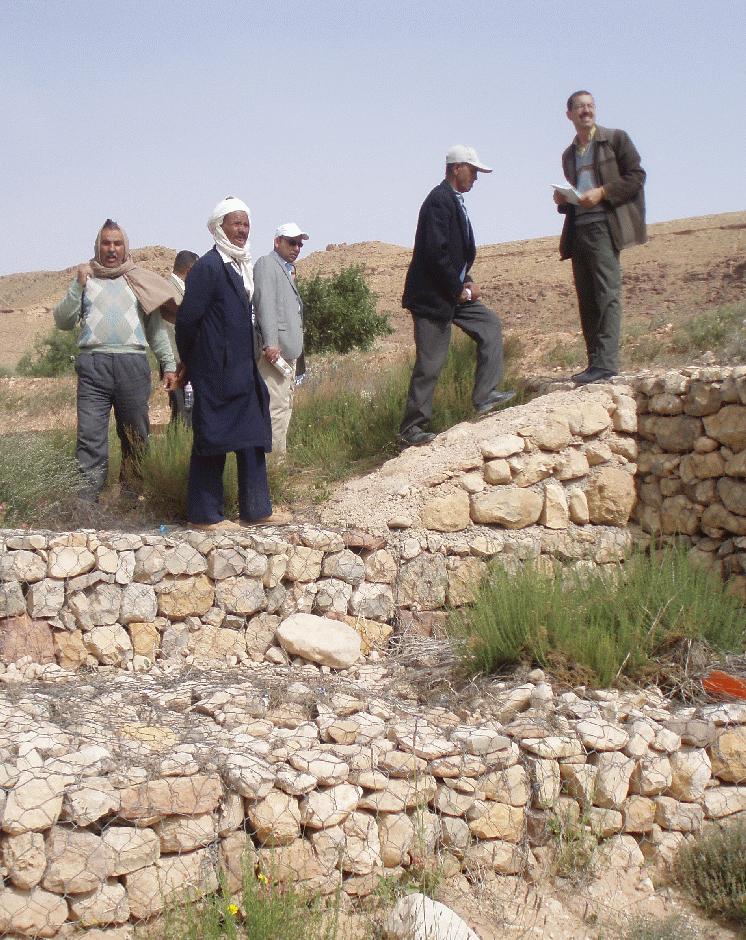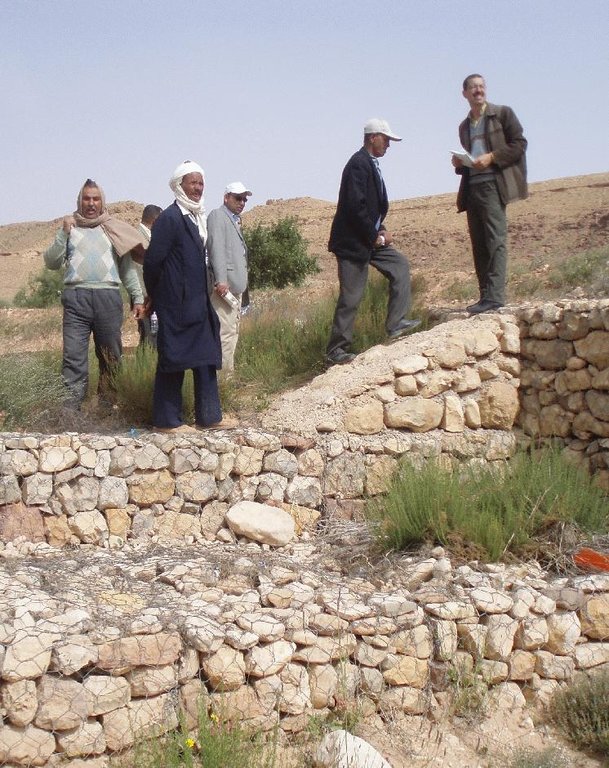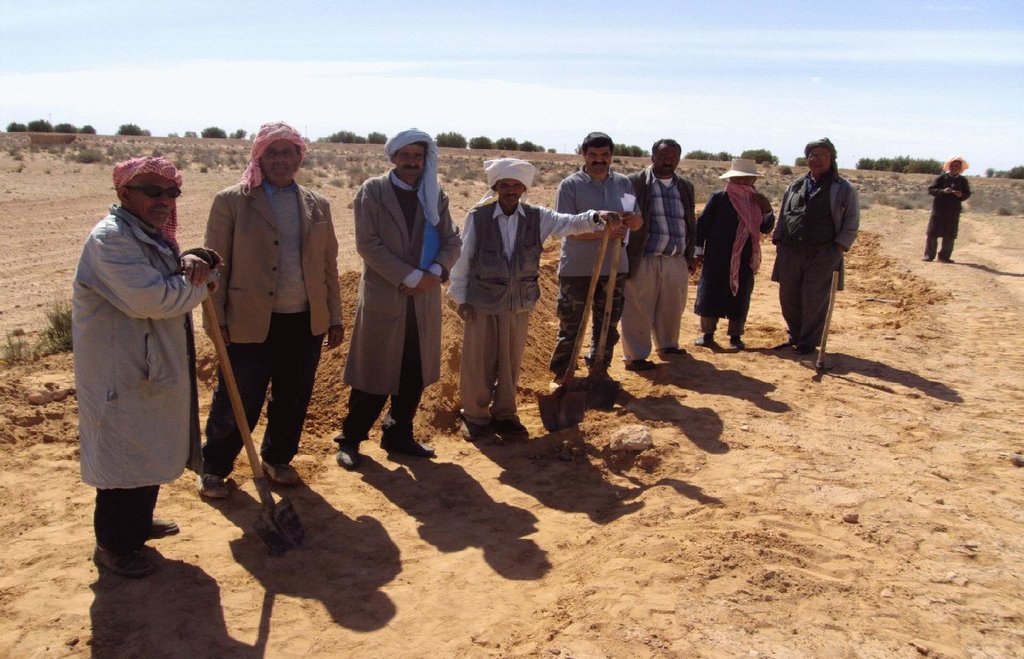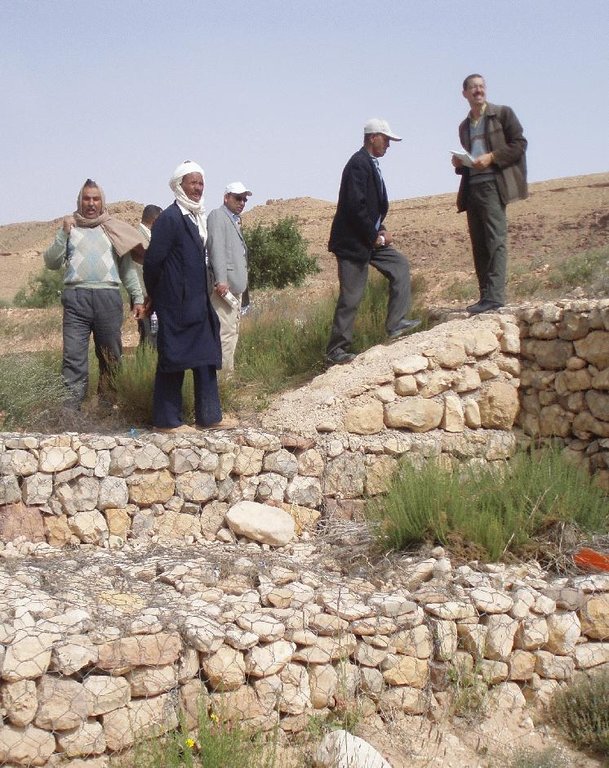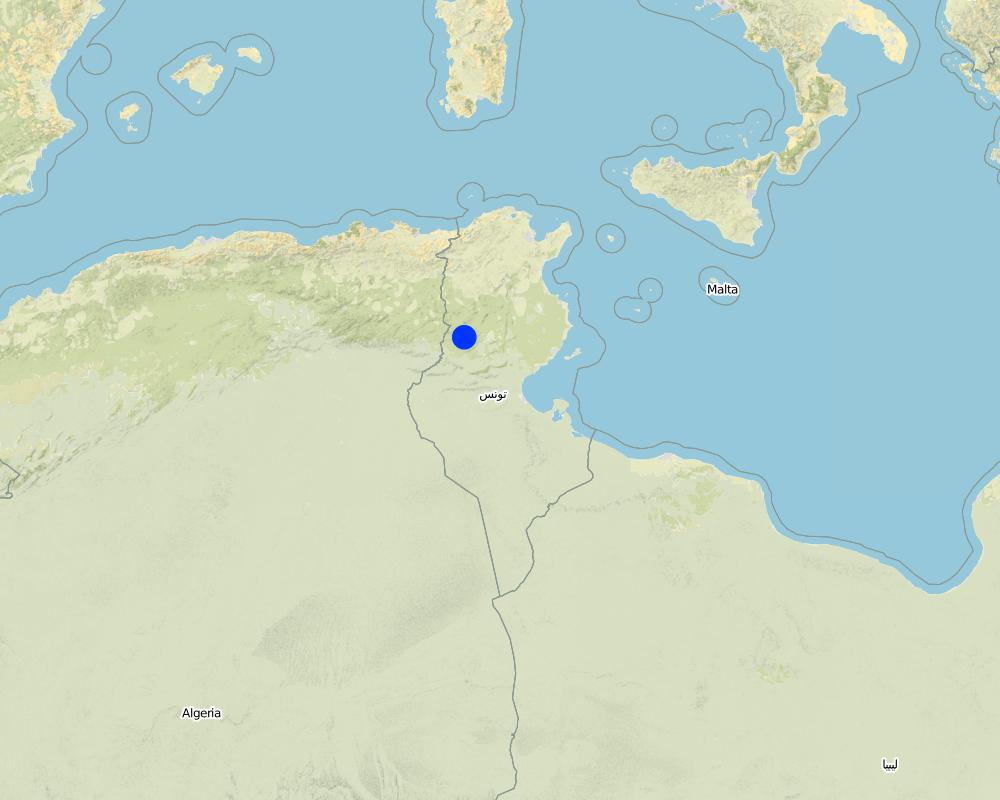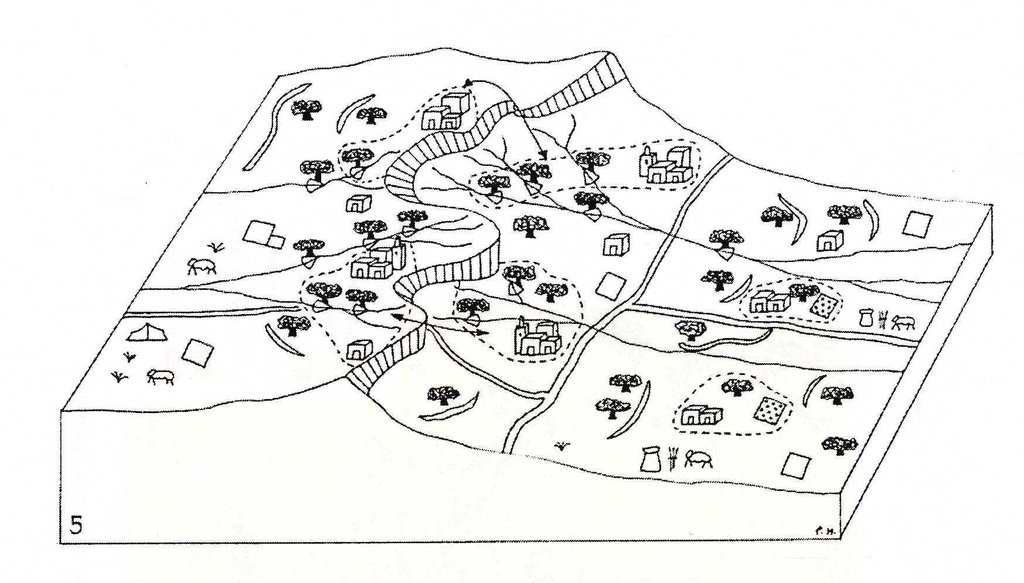Dryland watershed management approach [Tunisie]
- Création :
- Mise à jour :
- Compilateur : Naceur Mahdi
- Rédacteur : –
- Examinateurs : Fabian Ottiger, Deborah Niggli
approaches_2422 - Tunisie
Voir les sections
Développer tout Réduire tout1. Informations générales
1.2 Coordonnées des personnes-ressources et des institutions impliquées dans l'évaluation et la documentation de l'Approche
Spécialiste GDT:
Spécialiste GDT:
Sghaier Mongi
sghaier.mon@gmail.com
Institut des Régions Arides
4119 Medenine
Tunisie
Nom du projet qui a facilité la documentation/ l'évaluation de l'Approche (si pertinent)
DESIRE (EU-DES!RE)Nom du ou des institutions qui ont facilité la documentation/ l'évaluation de l'Approche (si pertinent)
Institut des Régions Arides de Médenine (Institut des Régions Arides de Médenine) - Tunisie1.3 Conditions relatives à l'utilisation par WOCAT des données documentées
Le compilateur et la(les) personne(s) ressource(s) acceptent les conditions relatives à l'utilisation par WOCAT des données documentées:
Oui
1.4 Références au(x) questionnaire(s) sur les Technologies de GDT
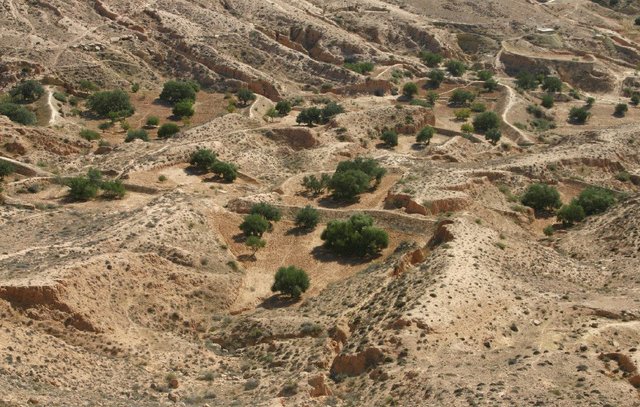
Jessour [Tunisie]
Le Jessour est une technique ancienne de récolte des eaux de ruissellement, très utilisée dans les zones montagneuses arides
- Compilateur : Mongi Ben Zaied
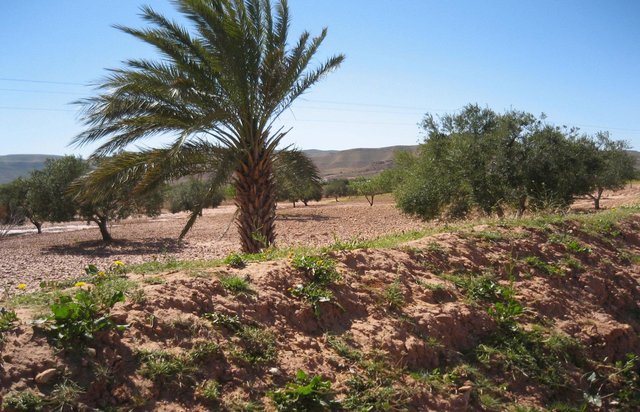
Tabia [Tunisie]
Le tabia, une digue en terre, est une technique de récolte de l’eau utilisée dans les fonds de vallées et les zones de piémont.
- Compilateur : Mongi Ben Zaied
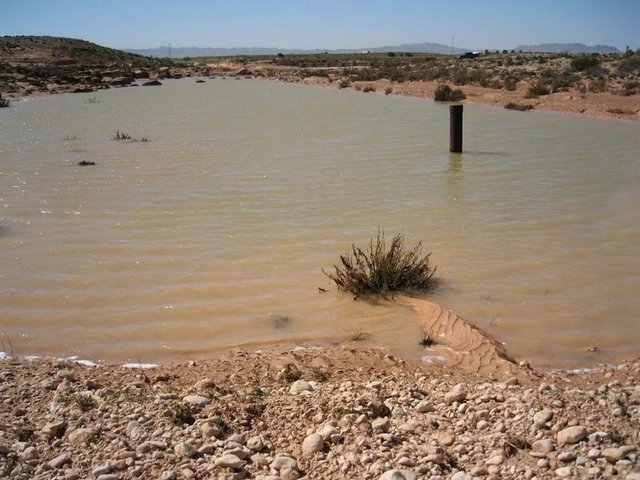
Puits filtrants [Tunisie]
Un puits filtrant est un puits foré à 30-40 m de profondeur, entouré d’un filtre et atteignant la nappe phréatique. Il permet de faire pénétrer l’eau directement dans l’aquifère.
- Compilateur : Mongi Ben Zaied
2. Description de l'Approche de GDT
2.1 Courte description de l'Approche
Integrated land and water management approach, including vegetative, management, and agronomic measure
2.2 Description détaillée de l'Approche
Description détaillée de l'Approche:
Aims / objectives: The overall purpose of the approach is to prevent soil and water loss by combined measures and to provide a better environment. Soil and water conservation (SWC) technologies, based on harvesting area of surface water and underground water, are implemented to conserve soil and water and to improve the production and the biodiversity.
Methods: This approach is designed for the exploitation of water runoff for agricultural development, particularly for fruit trees cropping (mainly olives).This can be achieved through erosion reduction and aquifer recharge via runoff water infiltration into the terraces, slope angle and length reduction, runoff retaining, infiltration increase and soil loss reduction. The system is based on various runoff water harvesting systems, as jessour, tabias. It is marked by fruit tree development, notably olives. On the terraces, the fruit trees are arranged in inter-rows with the three main species encountered in the study areas. Generally, olive trees are planted, with in between rows almonds and/ or fig trees. SWC technologies play an importance role in arid zones. Since the 1970s, the Tunisian state has encouraged the local population to conserve water and soil in arid zone. Successive programmes and strategies of water and soil conservation have been developed and were implemented in all three natural regions of Tunisia (North, Centre and South).These techniques can be implemented by farmer with governmental subsidies or by government intervention in the projects and programmes of water and soil conservation. During the last decade, the Tunisian government implemented the first national strategy for soil and water conservation (1990-2000) and the second national strategy for soil and water conservation (2001-2011). These strategies mobilized important funds at national and regional levels. About 672.5 ha of SWC technologies were built and about 550 ha of SWC technologies are planned for the second national strategy.
Stages of implementation: 1) Assessment of the current natural resources and socio-economic conditions; 2) Proposition of actions at local and regional level; 3) Aggregation and coherence at the national level; 4) implementation of national action plan at local and regional level.
Role of stakeholders: Different levels of intervention are observed from the individual farm, through the community level, the extension / advisory system, the regional or national administration, or the policy level, to the international framework. The participative approach is usually applied in the construction of SWC technologies.
2.3 Photos de l'approche
2.5 Pays/ région/ lieux où l'Approche a été appliquée
Pays:
Tunisie
Région/ Etat/ Province:
south-east of tunisia
Autres spécifications du lieu :
Oum Zessar Watershed
Map
×2.6 Dates de début et de fin de l'Approche
Indiquez l'année de démarrage:
1960
2.7 Type d'Approche
- initiative/ innovation récente locale
2.8 Principaux objectifs de l'Approche
The Approach focused on SLM only (production, soil fertility, biodiversity, employement oppourtunities, food self-sufficiency, fixing population and stop farming exodus)
The objectives of the approach are to control soil and water loss to reduce floods and enhance fertility, to enhance rainfed agriculture productivity, to improve the livelihoods of farmers, to contribute to the production increase among farmers and pastoralists, to recharge the groundwater and to extend the area of cropland.
The SLM Approach addressed the following problems: The problems originate in the scarcity of water which is leading to conflicts over resource use between farmers. Oversized techniques leading to prevention of runoff from upstream to downstream reduce agricultural production and therefore the farm income, which causes a lack of cash to invest in SLM. In some cases irreversible land degradation is the result. The problems are mainly related to the lack of technical knowledge, the high costs of investment and the lack of tangible and assessable impacts of SWC activities, technically or socially.
2.9 Conditions favorisant ou entravant la mise en œuvre de la(des) Technologie(s) appliquée(s) sous l'Approche
disponibilité/ accès aux ressources et services financiers
- entrave
High cost investment
Treatment through the SLM Approach: Public projects (National strategy of SWC), subsidies
cadre institutionnel
- entrave
Land fragmentation, complexity of land tenure,
Treatment through the SLM Approach: Users organisation, participation
cadre juridique (régime foncier, droits d'utilisation des terres et de l'eau)
- favorise
The existing land ownership, land use rights / water rights greatly helped the approach implementation: The approach helped in the privatization of the land and has therefore greatly reduced the land/water use rights problems. This in turn has rendered the local interventions much more efficient.
connaissances sur la GDT, accès aux supports techniques
- entrave
Designing parameters
Treatment through the SLM Approach: Training , Ehancing SWC specialists guidance
3. Participation et rôles des parties prenantes impliquées dans l'Approche
3.1 Parties prenantes impliquées dans l'Approche et rôles
- exploitants locaux des terres / communautés locales
Working land users were mainly men (Men are the main force for field work.)
Special attention has been paid to make women participate in the approach. Nevertheless, men have much more technical knowledge and skills than women because if SWC technologies have to be constructed by manual labour, men can achieve more. Poor and old people are especially involved through their participation in the special programme against unemployment in rural area. Some unemployed young people may benefit from agricultural development programmes.
- Spécialistes de la GDT/ conseillers agricoles
The choice on the technology to use is made primarily by the technical specialists based on the prevalent type of erosion on each farm and farmers preference.
- gouvernement national (planificateurs, décideurs)
- organisation internationale
Si plusieurs parties prenantes sont impliquées, indiquez l'organisme chef de file ou l'institution responsable:
National and state specialists together with land users.
3.2 Participation des exploitants locaux des terres/ communautés locales aux différentes phases de l'Approche
| Participation des exploitants locaux des terres/ communautés locales | Spécifiez qui était impliqué et décrivez les activités | |
|---|---|---|
| initiation/ motivation | interactive | Farmers and local population are very familiar with traditional SWC applied. Therefore the receptiveness to these techniques is very high. There is state encouragement through subsidies. |
| planification | interactive | Workshops/seminars; After a programme is granted, the implementing agency and local communities work together. |
| mise en œuvre | soutien extérieur | Responsibilities are divided into major steps; In practice, local communities are the major part to manage and carry out. |
| suivi/ évaluation | interactive | Participative evaluation; Interviews/questionnaires. |
| Research | interactive | It can give some suggestions or questionnaires. |
3.3 Diagramme/ organigramme (si disponible)
Description:
The treatment of the catchment starts from the upstream and continues to piedmont areas, and ends in the downstream section of the catchment. Attention should be given to ensure sufficient water allocation to all the sections of the catchment as well as to the different users (rainfed agriculture and rangelands, irrigated areas, drinking water, industry and tourism).
Auteur:
Patricia Home
3.4 Prises de décision pour la sélection de la Technologie/ des Technologies
Indiquez qui a décidé de la sélection de la Technologie/ des Technologies à mettre en œuvre:
- principalement les exploitants des terres soutenus par des spécialistes de la GDT
Expliquez:
consultative,explain
Decisions on the method of implementing the SLM Technology were made by mainly by SLM specialists with consultation of land users. Decisions are made by politicians/SWC specialists; land users are consulted in the planning phase (experienced farmers may be involved initially).
4. Soutien technique, renforcement des capacités et gestion des connaissances
4.1 Renforcement des capacités/ formation
Une formation a-t-elle été dispensée aux exploitants des terres/ autres parties prenantes?
Oui
Spécifiez qui a été formé:
- exploitants des terres
- personnels/ conseillers de terrain
Si pertinent, spécifiez le genre, l'âge, le statut, l'ethnie, etc.
The capacity building programme and activities have benefited farmers representing the diversity of land users (women and men); representatives of NGO; local and external stakeholders, engineers and technicians responsible of the services of agriculture and forest.
Formats de la formation:
- entre agriculteurs (d'exploitants à exploitants)
- zones de démonstration
- réunions publiques
Thèmes abordés:
Training focused on teaching them how to design and build SWC technologies, how to implement these technologies and about the participatory approach.
4.2 Service de conseils
Les exploitants des terres ont-ils accès à un service de conseils?
Oui
Spécifiez si le service de conseils est fourni:
- dans des centres permanents
Décrivez/ commentez:
Name of method used for advisory service: Integrated watershed management; Key elements: Training and demonstration open days, Demonstration plots implemented in private farms, Target farmers groups are visited by specialist to help and advise them.; 1) Advisory service was carried out through: government's existing extension system. Extension staff: mainly government employees 3) Target groups for extension: planners; Activities: training
Advisory service is quite adequate to ensure the continuation of land conservation activities; The extension system is adequate to ensure continuation of activities. At each governorate level, there is a SWC division which is in charge of SWC activities, including its extension.extension
4.3 Renforcement des institutions (développement organisationnel)
Des institutions ont elles été mises en place ou renforcées par le biais de l'Approche?
- oui, modérément
Spécifiez à quel(s) niveau(x), ces institutions ont été renforcées ou mises en place:
- local
Précisez le type de soutien:
- financier
Donnez plus de détails:
support with financial resources, capacity building, training, institutional support. The financial schema is made of three main components: self-financing from farmers and beneficiaries, subsidies from the government and credit from bank.
4.4 Suivi et évaluation
Le suivi et l'évaluation font ils partie de l'Approche? :
Oui
Commentaires:
economic / production aspects were ad hoc monitored by project staff through measurements; indicators: investigation/ of yield, income of land users, rainfed productivity
socio-cultural aspects were ad hoc monitored by project staff through observations; indicators: Investigation of land users perceptions of cultural change
bio-physical aspects were ad hoc monitored by project staff through measurements; indicators: Indicators are runoff loss, sediment load, soil moisture
area treated aspects were ad hoc monitored by government through measurements; indicators: Impact assessment
management of Approach aspects were None monitored by government through measurements; indicators: None
There were few changes in the Approach as a result of monitoring and evaluation: for example at the institutional level.
4.5 Recherche
La recherche a-t-elle fait partie intégrante de l’Approche?
Oui
Spécifiez les thèmes:
- technologie
- approaches
Donnez plus de détails et indiquez qui a mené ces recherches:
Land users have been involved. SWC technologies construction is based on scientific design, according to local conditions.
Research was carried out both on station and on-farm
5. Financement et soutien matériel externe
5.1 Budget annuel de la composante GDT de l'Approche
Si le budget annuel précis n'est pas connu, indiquez une fourchette:
- 10 000-100 000
Commentez (par ex. principales sources de financement/ principaux bailleurs de fonds):
Approach costs were met by the following donors: local community / land user(s): 20.0%; national non-government: 5.0%; government: 55.0%; international: 20.0%
5.2 Soutiens financiers/ matériels fournis aux exploitants des terres
Les exploitants des terres ont-ils reçu un soutien financier/ matériel pour la mise en œuvre de la Technologie/ des Technologies?
Oui
5.3 Subventions pour des intrants spécifiques (incluant la main d'œuvre)
- équipement
| Spécifiez les intrants subventionnés | Dans quelle mesure | Spécifiez les subventions |
|---|---|---|
| machines | en partie financé | |
- matériaux de construction
| Spécifiez les intrants subventionnés | Dans quelle mesure | Spécifiez les subventions |
|---|---|---|
| pierres | en partie financé | |
Si la main d'œuvre fournie par les exploitants des terres était un intrant substantiel, elle était:
- volontaire
Commentaires:
Voluntary but rewarded with in-kind support by government subsidies
5.4 Crédits
Des crédits ont-ils été alloués à travers l'Approche pour les activités de GDT?
Oui
Spécifiez les conditions (taux d'intérêts, remboursements, etc.):
repayment conditions: Credit was promoted through agricultural banks with various interest rates, usually lower than market rates.
6. Analyses d'impact et conclusions
6.1 Impacts de l'Approche
Est-ce que l'Approche a aidé les exploitants des terres à mettre en œuvre et entretenir les Technologies de GDT?
- Non
- Oui, un peu
- Oui, modérément
- Oui, beaucoup
Land users can harvest water and irrigate crops in dry seasons. Meanwhile, the cropland area is enlarged.
Est-ce que l'Approche a autonomisé les groupes socialement et économiquement défavorisés?
- Non
- Oui, un peu
- Oui, modérément
- Oui, beaucoup
for disadvantaged women and men, there are employment opportunities and food self-sufficiency
Est-ce que l'Approche a amélioré les questions foncières et des droits d'utilisation qui entravent la mise en œuvre des Technologies?
- Non
- Oui, un peu
- Oui, modérément
- Oui, beaucoup
Did other land users / projects adopt the Approach?
- Non
- Oui, un peu
- Oui, modérément
- Oui, beaucoup
Did the Approach lead to improved livelihoods / human well-being?
- Non
- Oui, un peu
- Oui, modérément
- Oui, beaucoup
because of increased farm income.
Did the Approach help to alleviate poverty?
- Non
- Oui, un peu
- Oui, modérément
- Oui, beaucoup
this appraoch increase farm income, food self-sufficiency and employer opportunities
6.2 Principale motivation des exploitants des terres pour mettre en œuvre la GDT
- augmenter la production
increase yield; Food self-sufficiency
- augmenter la rentabilité/ bénéfice, rapport coûts-bénéfices
increase farm income
- paiements/ subventions
invest in SWCT
- well-being and livelihoods improvement
Employer opportunities
6.3 Durabilité des activités de l'Approche
Les exploitants des terres peuvent-ils poursuivre ce qui a été mis en œuvre par le biais de l'Approche (sans soutien extérieur)?
- incertain
Si non ou incertain, spécifiez et commentez:
Can given the recent escalation in payments made to land users for implementation under certain projects it seems that the costs will be too high to sustain. Currently the Ministry of Agricultural is demanding that in-depth cost-benefit analyses are carried out involving environmental, social as well as economic assessments
6.4 Points forts/ avantages de l'Approche
| Points forts/ avantages/ possibilités du point de vue de l'exploitant des terres |
|---|
| Reduction of soil erosion (How to sustain/ enhance this strength: ensure the durability of the works implemented) |
| Points forts/ avantages/ possibilités du point de vue du compilateur ou d'une autre personne ressource clé |
|---|
| Improvement of livelihood (How to sustain/ enhance this strength: spreading and improvement of a more holistic SLM approach focusing on livelihoods) |
| Many people involved and trained at different levels (pyramid system) (How to sustain/ enhance this strength: participatory approach) |
| More participation and involvement of local population (How to sustain/ enhance this strength: Improve participatory approach and increase confidence between partners) |
6.5 Faiblesses/ inconvénients de l'Approche et moyens de les surmonter
| Faiblesses/ inconvénients/ risques du point de vue de l’exploitant des terres | Comment peuvent-ils être surmontés? |
|---|---|
| Abandonment of the works, less maintenance | Continue to support farmers and local institution and organisation. Repairing and maintaining in time. |
| Low impact on livelihood conditions | improve efficiency of SWC activities and participatory approach |
| Faiblesses/ inconvénients/ risques du point de vue du compilateur ou d'une autre personne ressource clé | Comment peuvent-ils être surmontés? |
|---|---|
| Less confidence between partners and less participation | improve dialog and communication; improve efficiency of SWC activities and participatory approach. |
| High costs: farmers depend on external support from the government; they are not willing to invest their labour without payments | New approach should give farmers loans for construction as now they use machines to do the work. In addition, search for cheaper SWC technologies and for improving the benefits. |
7. Références et liens
7.1 Méthodes/ sources d'information
- visites de terrain, enquêtes sur le terrain
- interviews/entretiens avec les exploitants des terres
7.2 Références des publications disponibles
Titre, auteur, année, ISBN:
Genin D., Guillaume H., Ouessar M., Ouled Belgacem A., Romagny B., Sghaier M., Taamallah H. (Eds) 2006. Entre la désertification et le développement : la Jeffara tunisienne. CERES, Tunis; de Graaff J. & Ouessar M. (Eds.) 2002Water harvesting in Mediterranean zones: an impact assessment and economic evaluation.
Disponible à partir d'où? Coût?
TRMP paper n° 40, Wageningen University, The Netherlands
Titre, auteur, année, ISBN:
Water harvesting in Mediterranean zones: an impact assessment and economic evaluation.
Disponible à partir d'où? Coût?
TRMP paper n° 40, Wageningen University, The Netherlands
Liens et modules
Développer tout Réduire toutLiens

Jessour [Tunisie]
Le Jessour est une technique ancienne de récolte des eaux de ruissellement, très utilisée dans les zones montagneuses arides
- Compilateur : Mongi Ben Zaied

Tabia [Tunisie]
Le tabia, une digue en terre, est une technique de récolte de l’eau utilisée dans les fonds de vallées et les zones de piémont.
- Compilateur : Mongi Ben Zaied

Puits filtrants [Tunisie]
Un puits filtrant est un puits foré à 30-40 m de profondeur, entouré d’un filtre et atteignant la nappe phréatique. Il permet de faire pénétrer l’eau directement dans l’aquifère.
- Compilateur : Mongi Ben Zaied
Modules
Aucun module trouvé


